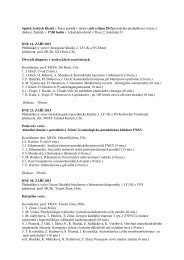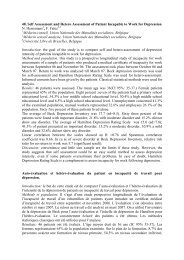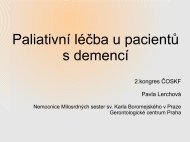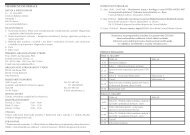ABSTRACTS â ORAL PRESENTATIONS - AMCA, spol. s r.o.
ABSTRACTS â ORAL PRESENTATIONS - AMCA, spol. s r.o.
ABSTRACTS â ORAL PRESENTATIONS - AMCA, spol. s r.o.
You also want an ePaper? Increase the reach of your titles
YUMPU automatically turns print PDFs into web optimized ePapers that Google loves.
P21. ASSESSMENT OF MITOCHONDRIAL FUNCTIONS<br />
Barbora Pavlů, Jan Černý<br />
Faculty of Science, Charles University in Prague, Czech Republic;<br />
barbora.pavlu@natur.cuni.cz<br />
Mitochondria have become targets for activating specific killing of cancer cells and as<br />
a consequence this creates a need for assessment of drugs targeting mitochondria.<br />
To test effects of these substances - so called ”mitocans”( Ralph et al., 2006) - on<br />
mitochondria we employed MitoTracker ® Red CMXRos ( Molecular Probes® Invitrogen<br />
detection technologies), that is chloromethyl-X-rosamine. This fluorescent probe is<br />
retained in active mitochondria and its accumulation is dependent upon membrane<br />
potential. Results obtained with this mitochondrion selective probe by FACS analysis<br />
correspond with qualitative data from fluorescence microscopy. We found that working<br />
concentration for FACS analysis is between 2-5 nM.<br />
Suggested mechanism of induction of apoptosis by mitocans is a production of reactive<br />
oxygen species (ROS), which affect mitochondria in multiple ways (Neužil et al., 2006).<br />
To test production of ROS in cells treated by mitocans we used CellROX ® Green Reagent<br />
( Molecular Probes® Invitrogen detection technologies). This probe is non-fluorescent in<br />
reduced state. After oxidation it becomes fluorescent and binds to DNA. Once again data<br />
from FACS analysis were in agreement with fluorescence microscopy. We found that<br />
working concentration for FACS analysis is between 10-30 µM.<br />
These two probes are compatible for use in multicolour experiments and are suitable for<br />
assessment of mitochondrial functions in cells treated by mitocans.<br />
Acknowledgements<br />
This work was supported by Grant Agency of the Czech Republic (P302/13/16565S), the<br />
Czech Ministry of Education, Youth and Sports of the Czech Republic (MSM0021620858)<br />
and by the grant SVV (265211).<br />
References<br />
Neuzil J, Wang XF, Dong LF, Low P, Ralph SJ.: Molecular mechanism of ‘mitocan’-induced<br />
apoptosis in cancer cells epitomizes the multiple roles of reactive oxygen species and<br />
Bcl-2 family proteins. - FEBS Lett. 2006 Oct 2;580(22):5125-9.<br />
Ralph SJ, Low P, Dong L, Lawen A, Neuzil J.: Mitocans: mitochondrial targeted anti-cancer<br />
drugs as improved therapies and related patent documents. - Recent Pat Anticancer<br />
Drug Discov. 2006 Nov;1(3):327-46.<br />
112 Analytical Cytometry VII








